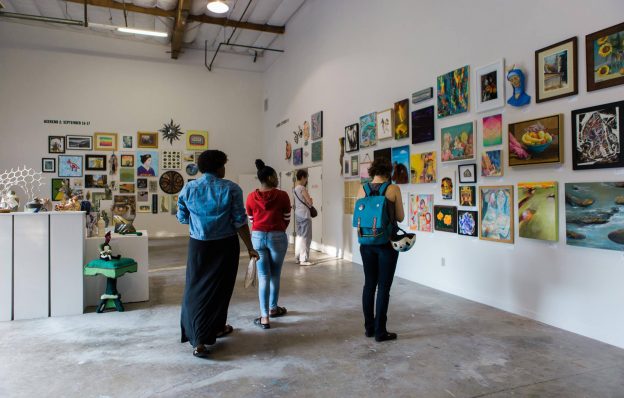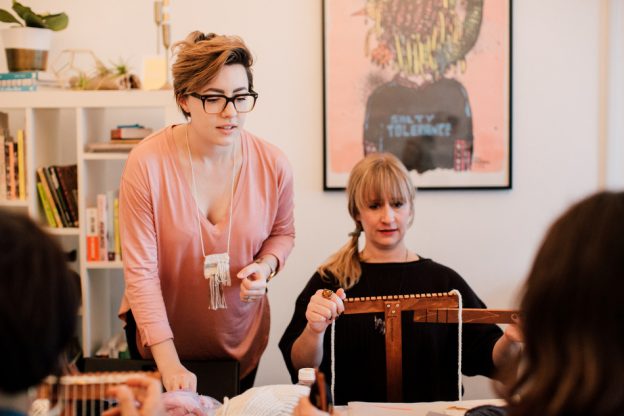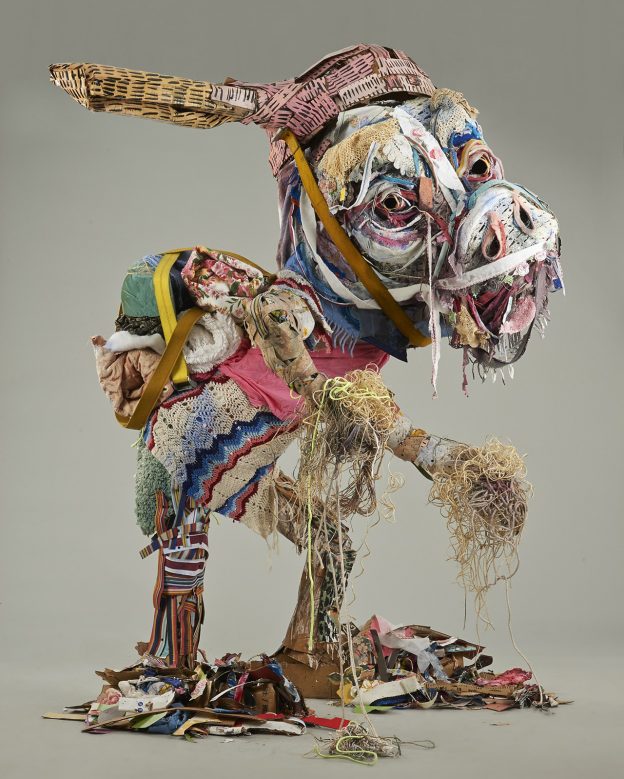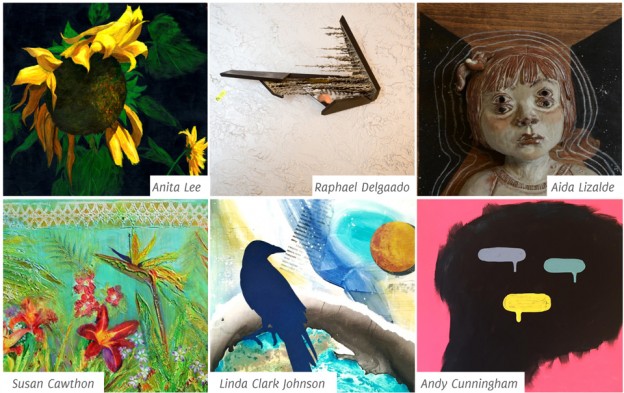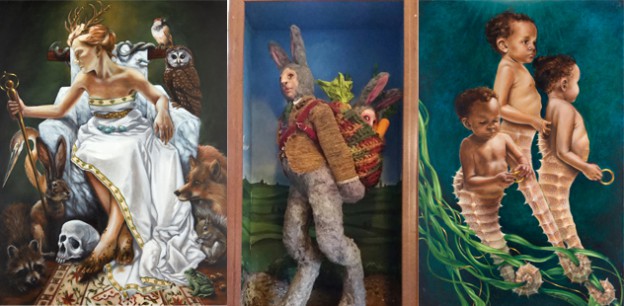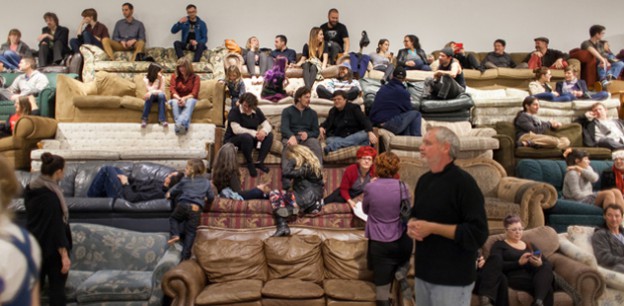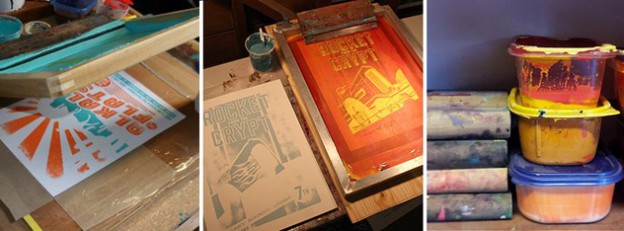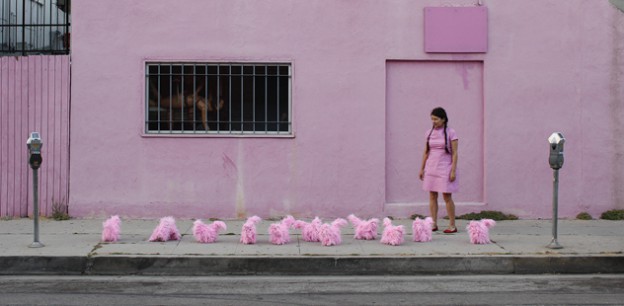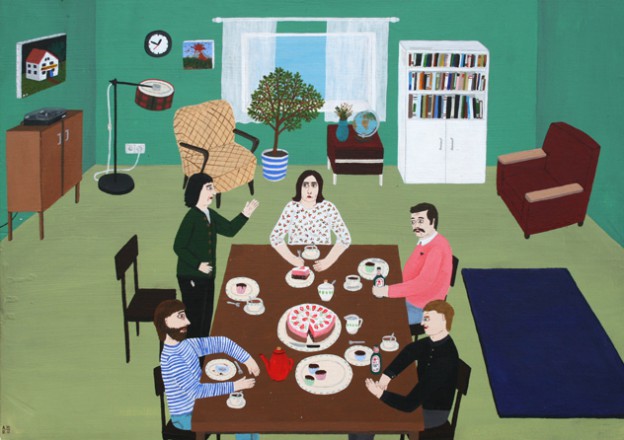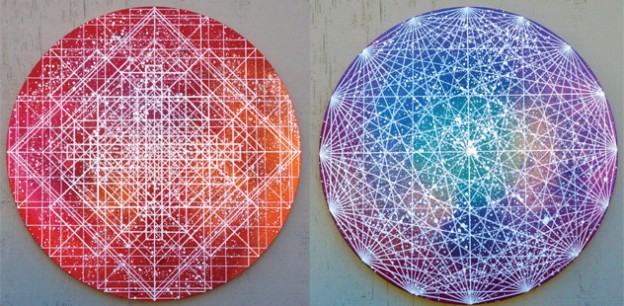For two weekends only, Sacramentans will have the opportunity to experience emerging and established local artists in their artistic element. More than 250 artists and 119 studios in Sacramento County and the West Sacramento areas will be featured in a self-guided art tour where you will get to meet local artists, participate in live art activities and open your horizons to the astonishing talent that Sacramento has to offer. The first weekend of Sept. 14–15 (10 a.m.–5 p.m.) will focus on artists and studios west of Highway 99 and Interstate 80, and the second weekend of Sept. 21–22 (also 10 a.m.–5 p.m.) will focus on talent east of Highway 99 and Interstate 80. Verge Center for the Arts, the hosts of this special event, have curated an 86-page guidebook on their website Vergeart.com where you can explore all of the participating artists and studios so that you can plan your own tour. This event is even more special, as it is dedicated to former Sacramento mayor Burnett Miller, who passed in October 2018 and was a founding member of the Center for Contemporary Arts Sacramento. Come enjoy the beauty and vivacity that Sacramento has to offer at this awesome event.
**This write-up first appeared in print on page 12 of issue #300 (Sept. 11 – 25, 2019)**
Need a unique gift idea for the stylish, artsy person on your shopping list? Looking to up your DIY game? At Verge Center for the Arts’ upcoming Holiday Weaving Workshop, taking place Dec. 14-15, you’ll learn how to create stunning, texture-filled, woven wall-hanging art, one of the biggest crazes in the DIY world. No experience is necessary and you’ll be in good hands, as the course is being lead by local fiber artist and owner of The Northern Needle Co., Jessica Filip. Get hands-on instruction on how to dress the loom, start the weaving, create your design, and how to tie it off to finish. The registration fee ($115) includes a small lap loom and weaving tools that you will take home at the end of the workshop, so you can build upon the basics you learn here and continue to hone your skills! Space is limited, so sign up soon at Vergeart.com. Learn more about the instructor and take a peek at some of her amazing work at Thenorthernneedle.co.
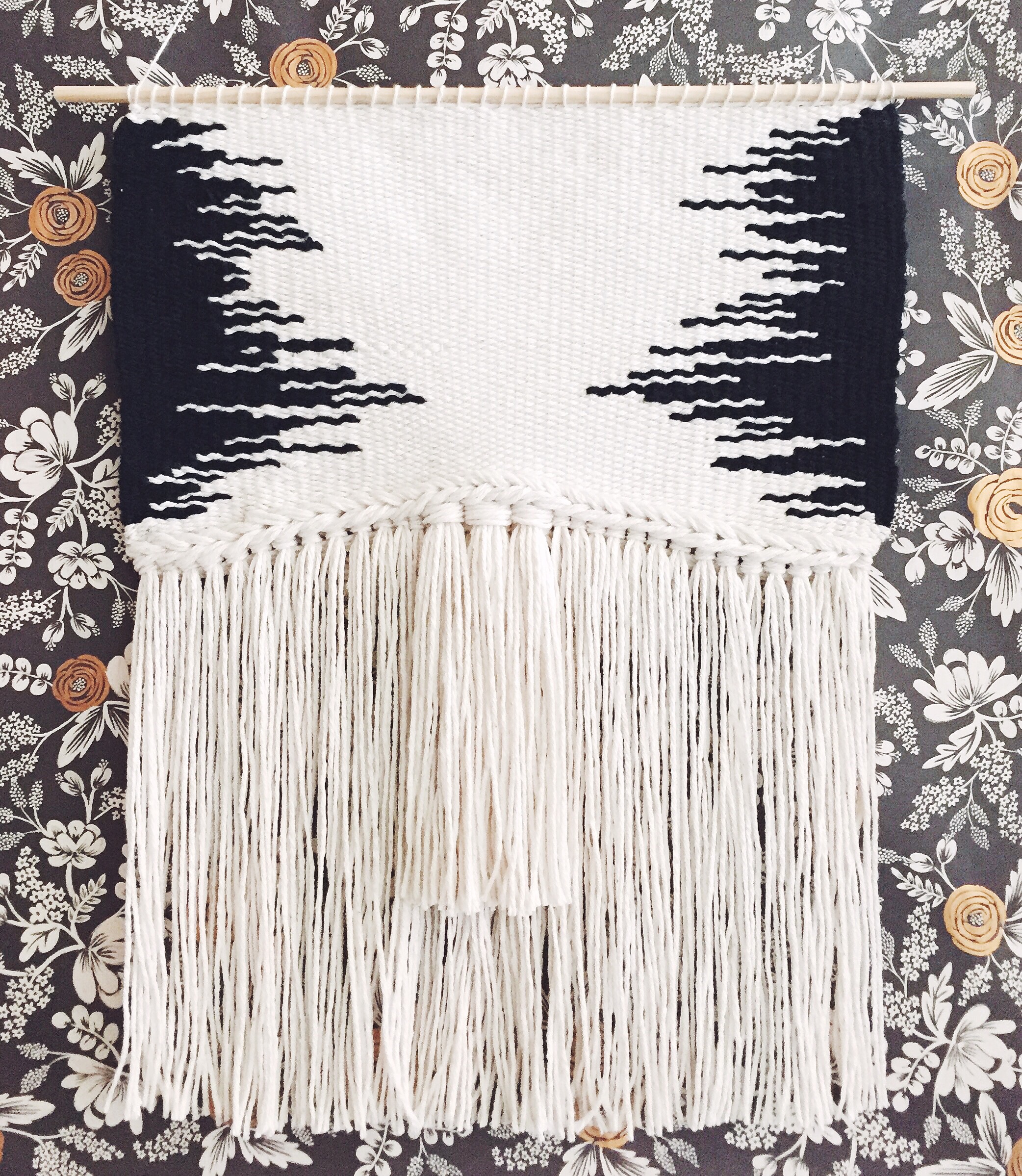
This write-up first appeared in print on page 10 of issue #227 (Nov. 21 – Dec. 5, 2016). We originally reported that the workshop was taking place Dec. 7-8, but organizers have since pushed it back to Dec. 14-15, 2016.
(This is Not a) Love Song is a new body of work by Sacramento artist Elisabeth Higgins O’Connor at Verge Center for the Arts. Sitting on a folding chair in the literal shadow of her sculptures, without the buzz and hum of the crowd from the opening reception, was surreal. It brings to mind the idea of sitting in a workshop of Disney animatronics, after-hours; skin peeled back to reveal the elaborate patchwork underneath.
Higgins O’Connor creates large-scale, fantastical works, joining massive animal heads with bodies resembling that of a human. They are constructed with discarded domestic textiles and wood framing. Imagine a tornado ripping apart a house, and the entire contents reassembling themselves loosely in the form of these hulking, enormous fantasy structures. Their postures almost seem vulnerable or self-conscious.
The artist makes no attempt to craft a slick or seamless sculpture, and in turn puts their inner workings on display. Bedsheets cut into thousands of pieces—hardened and dissected—form the skin of one. Colored cardboard tacked like shingling onto the exterior of another. It’s the sheer amount of hand carved materials painstakingly arranged that make the viewer step back in awe.
The opening reception on Sept. 8 was a chance for the public to walk amongst Higgins O’Connor’s massive-scale, animal-like creatures, in a show with fellow UC Davis alumni Mathew Zefeldt, with his work titled Windows. Both of these are on display until Oct. 16, so make your way over to Verge before it’s gone. This show is the last of four shows celebrating the partnership between Verge Center for the Arts and the Manetti Shrem Museum of Art at UC Davis, which will open on Nov. 13, 2016.
On Tuesday, Submerge had a chance to sit down with the artist and ask some silly questions.
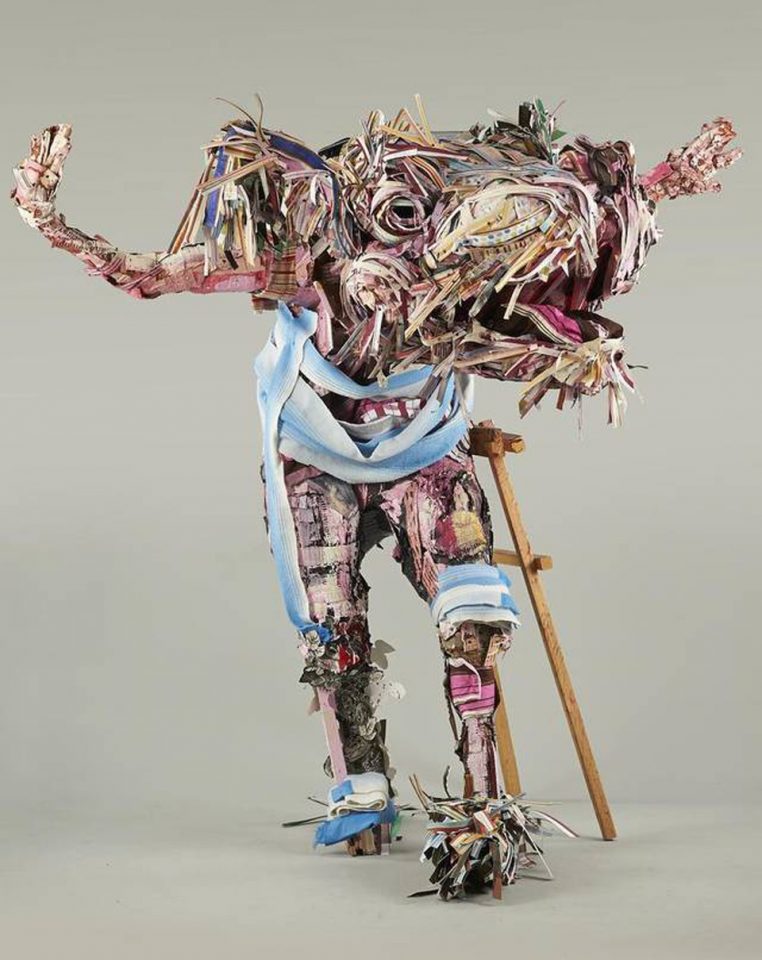
What do you feel like influenced your current body of work?
I’m interested in animals as a storytelling device. I’m interested in the democracy of materials, you know, everything in here is free or off Craigslist or from the thrift store, or like, the cardboard is from the Co-op. All of the paint is the reject paint from Home Depot, so there’s a language of things that have been left behind, or things that are free, materials that anyone can use. I’m not using anything fancy, really, not anything that you’d have to go to an art supply store for. And so I’m interested in that, even though it might not look that way, but I’m interested in those materials that are languishing or at a thrift store. My favorite thrift store here is that Thrift Town.
On Del Paso?
Yeah that’s the best Thrift Town, for me. And the bedding section’s always really orderly. So it’s things like that, like fabrics that are out of step, or things that don’t fit into a domestic setting anymore. I’m interested in domestic objects that once provided comfort that are no longer providing comfort.
I think that the common thread throughout the work has been the domestic textiles, like the blankets and pillows and bedsheets, because they’re loaded with content, for me, and it’s cheap, or relatively free, and I can paint with it, so I’m not buying really expensive acrylic paint or oil paint, but I can make a big red swathe without buying a $20 tube of paint
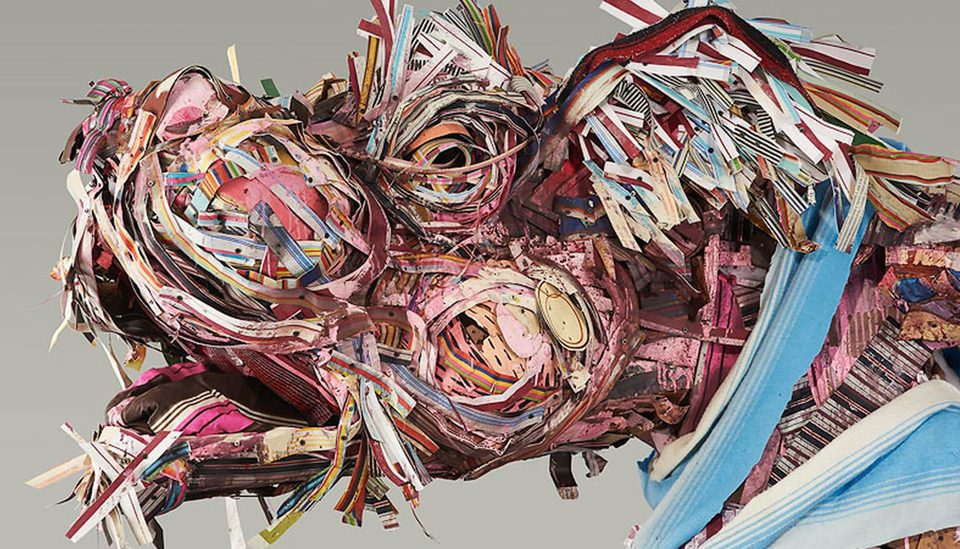
In your childhood, were you interested in animals that take on human form?
I think I’ve always been interested in animals, not to have them as pets necessarily, but they drive a narrative, and often times, morality tales or fables. Sometimes they’re thousands of years old, and they’ve been passed on through tradition or oral tradition; animals are often used to point out human foibles or society’s ills.
I think as a kid I was denied stuffed animals because I had a lot of allergies and asthma, I think about that a lot. I don’t think I’ve really told too many people that, but I was very jealous of kids that had lots of stuffed animals, and I kind of wonder about that; was that a seed that was planted, like, maybe I’ll make my own eventually.
When did you discover a need to create or draw, was it at a young age?
I don’t really remember, I think one of my earliest memories is drawing, and saying that I’m an artist, like in kindergarten or before kindergarten, and I don’t know exactly how that came about, but I always identified as an artist, even as a really little kid. And I was supported by my parents. My parents weren’t well-to-do, but they supported whatever we wanted to do … They never discounted any of our pursuits.
Do you have gestures in mind for your sculptures before you start them?
The three newest ones, yes, because they started from drawings, but for the older ones I don’t.
They’re intentionally clumsy. Coming from that ceramic background, my work was really tight.
I’m building them intentionally kind of clunky and awkward. Like, there are elements where they’re extremely elegant, like around the eyes and the mouth, there’s this precision of like very dainty things like a lot of that face is put together with quilting pins, and cut out really fragile paper and bedsheet bits, and then there are moments where it’s devolving into complete awkwardness and clumsiness. I think something about incorporating both ends of that spectrum in the piece are interesting to me.
I’m not trying to hide how they are made, and I’m not trying to be a magician and have it look extremely tight all the way through.
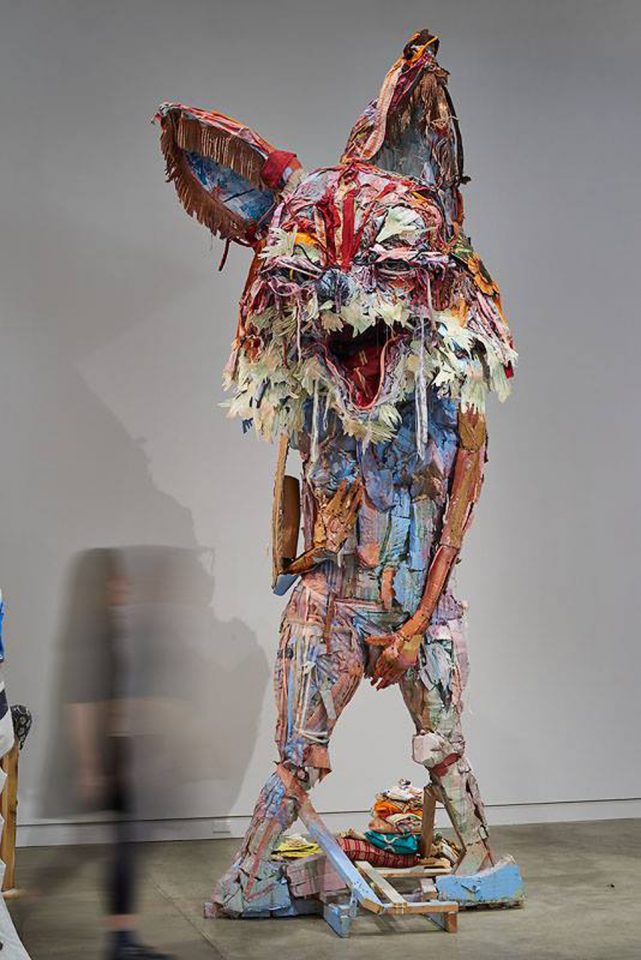
Was there a time when you feel like you wanted to move away from things being really tight to being more organic or loosely structured, or chaotic? Was it a gradual shift?
Yeah, I think in the ‘90s I was very well known for bodies of work that were very tight ceramic work and they were kind of doll-like, you know with human bodies and animal heads, but porcelain, and very tight.
And then 9/11 happened and the art market sort of fell apart temporarily. I was teaching at Cal State Long Beach, and something about, there was this break, there was this moment in time, there was this line in the sand where the world was rigid, and then 9/11 happened, and then the world was breakable. So something about that affected the work and me, so I think the language of destruction, the language of war-torn landscape. I think the work is born out of a lot of righteous anger with the system.
I think I still find it mind-boggling that those buildings came down, you know, nothing is permanent, and ceramics are so permanent. We don’t even know how long ceramics can last. Fired clay doesn’t degrade, so there’s something really heroic about that, and I wasn’t interested in that anymore. I was interested in fragility, and I was interested in ephemera and interested in things not lasting forever, and things falling apart, and being put together, and things falling apart, and still being put back together. That notion of patching, and things falling and taking care of something, and it still falls apart but you still put it back together.
Are there any artists that are inspiring you right now?
I really like David Altmejd’s work. He’s a figurative artist; very strange figurative work that’s very, very, large scale, like the heroic male, but he’s using wigs and glass eyes, and the bodies have the cavities and caverns in them where they’re part landscape, they’re really fantastic. He’s a huge influence.
And I also love the work of Joyce Pensato, who’s a painter who makes these rather expressionistic, super large-scale portraits of cartoon characters, like Homer Simpson, or Mickey Mouse, or Donald Duck, but they look like they’ve been made with a giant paint sprayer. They’re very large scale. Sometimes she’s invited into these spaces where she’s painting or drawing on the wall, and it’s just like, splattered everywhere, it looks like a slasher movie mixed with Donald Duck’s face! It’s usually just black and white and charcoal, or black and white paint. There’s some amazing images of her studios over the years, with paint everywhere, just kind of that wonderful looseness, to be able to have that much freedom, and not have to worry about getting paint all over the floor, or ruining someone’s studio if you’re renting a space or even at home.
That’s been holding me back, because for the past number of years I’ve been like a visiting artist at places or I will be installing work for over a month in a space, but you know, being in a place like this or in a place with black polished marble floors, or the space in Seattle, once the work got to the site there was still a lot of things I had to do, but it had a heritage terrazzo floor, so I couldn’t like drip paint or anything in there. So thats been a hindrance, so it was really wonderful, to make, for the two months I was in Seattle, it was a metal fabrication building it was just filthy, but it was huge, and my space was huge, and I just had the ability to drip paint and splatter paint, and the landlord was fine with it, and because the place was so filthy from all this black dust from metal grinding, and industry over years, the paint actually made it cleaner, because the paint would just fall on the floor and pool up and dry up, and when you’d peel it up, because it was so dirty it would just peel up like a Biore strip off the floor, so I actually cleaned it up with my process.
Is there another body of work you’re going to be working on in the immediate future?
Immediate future, not right this second. The three (largest) pieces are going back to the Vancouver Art Center.
I have an installation that will be at the Contemporary Jewish Museum in San Francisco next fall. It’s a show that’s based on Jewish fables, so I’ve been invited to create some work as a response to the story of the golem. That’s the next body of work that I’m going to spend time on.
Time is running out to see Elisabeth Higgins O’Connor’s (This is Not a) Love Song at Verge Center for the Arts, located at 625 S St. in Sacramento. Her exhibit is being shown alongside Windows by Mathew Zefeldt until Oct. 16.
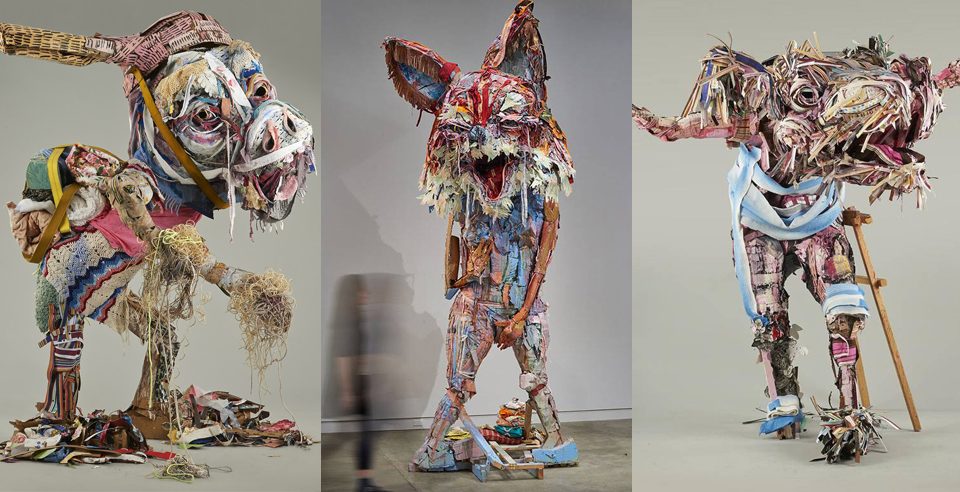
If you’ve ever wanted to know what it looks like inside regional artist’s studios and workspaces, here’s your chance. Verge Center for the Arts is presenting the 11th Annual Sac Open Studios, a free, self-guided tour that spans across two weekends, Sept. 10–11 and Sept. 17–18. Upwards of 150 contemporary artists from the area are opening up their spaces for anyone and everyone to roll through, so be sure to pick up your free copy of the official Sac Open Studios guide (available now at many local businesses) to start planning out your own personal tour. Think of it as a choose-your-own-adventure art experience! You can interact with the different artists and purchase work directly from them in an intimate setting. There is also a big kick-off party at Verge (625 S St.) on Sept. 8 that will double as the opening of solo shows from Minneapolis artist Mathew Zefeldt and Sacramento artist Elisabeth Higgins O’Connor. Learn more at Vergeart.com.
Artist Laurelin Gilmore showcases the beauty of everyday with unexpected imagery
Sacramento has always wanted to be a primary market, but as far as attendance at art and music gatherings go, has been a tertiary market at best. In the last decade, however, artists like painter/sculptor/illustrator Laurelin Gilmore have managed to eke out a living doing what they love most: working full-time on art. Not only is Gilmore an artist on the rise, she has won several awards and the approval of many fans and venues alike.
On any given day during the traditional Monday-through-Friday work week, you can find Gilmore holding court at Verge Center For The Arts (625 S Street, Sacramento), working on her craft. Because her rent is manageable, she is able to have a space away from her home in North Sacramento, where she currently resides with her husband and 8-year-old daughter who she says is “a better artist than I was at her age.”
“Being an artist is not a self-sufficient entity and my husband does need to work,” Gilmore recently said in a telephone interview. “However, it is my full-time job and I spend about five hours a day in the studio and have 24-hour access to come and go as I please. It’s great to have somewhere to go and create if I feel the desire late at night. On weekends, I usually spend my time with my family unless I have a show somewhere.”
For the uninitiated, Gilmore’s work is highly colorful, whether she’s doing drawings, paintings or three-dimensional sculptures.
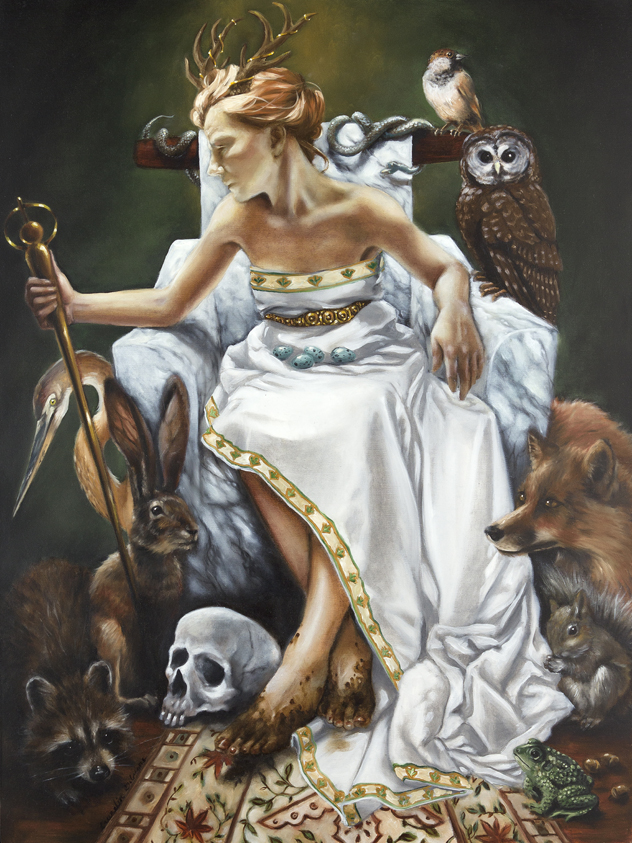
{The Queen Having Made Her Choice}
“I have been drawing as long as I could hold a crayon,” she says. “It’s really hard to quantify how many drawings or handmade pieces I’ve made over the years, but drawing was my first love. Up until 1998, I was strictly a pencil, graphite, chalk and charcoal artist.”
Gilmore says it was “just kind of a natural extension from hand drawings to expand and add texture and form” when she began painting.
“I’m still an advocate of drawing in its primitive and primary form, however.”
However, there is one medium that Gilmore doesn’t excel in. “I don’t do very well with colored pencil,” Lauren admits. “Using a colored pencil creates too fine of a line. If you cover a large area with colored pencil, you lose immediacy in the piece and it takes much more time. Rather than drawing a sky with colored pencils as a medium which can take hours, painting is far more expressive and, similarly, more colorful to view.”
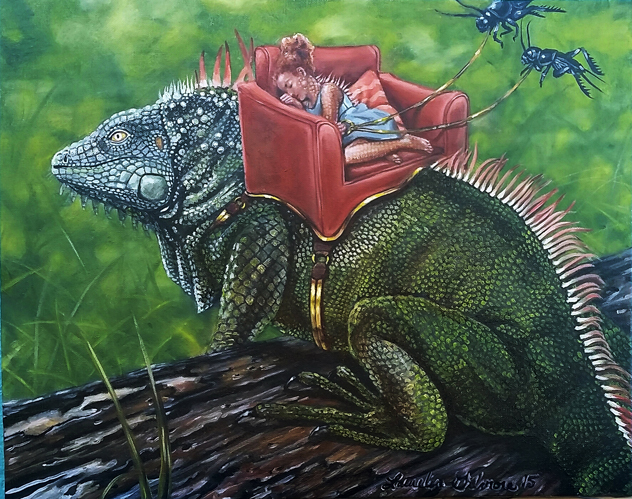
{Dragons}
In her artist’s statement, Gilmore says her subject matter “can be somewhat varied, but the human figure has always been my touchstone. My goal is to record on the paper or canvas as well I can the beauty of everyday through realism, surrealism and fantasy. My art looks at the place where separates meet, and explores through fantasy the experience of the would-be fence sitters as go-betweens, translators, and bridges between perspectives.”
Gilmore admits the collection she’s preparing for her show in September is one she’s “most excited about and terrified of creating.
“This is the most personal art I’ve ever made,” she says. “I am painting my experience as a person living with vitiligo…a skin condition that turns patches of skin white. I am using as models a couple of people who also have the condition and using myself as well to explore it as something beautiful and strange and strangely beautiful, I guess. Reactions span the spectrum, so I look forward to engaging viewers in a discussion on the topic that is motivated by seeing me and mine in a different light.”
Gilmore’s 20-plus-year tenure in the Sacramento Valley has garnered her fans, accolades and an appreciation for the Sacramento art community. She earned degrees in Fine Arts and Library Sciences from Sacramento City College and soon put down roots.
“Since I once lived in San Francisco, I always thought I could someday return there,” she says. “I have lived in Sacramento for over 20 years and it’s very affordable. In San Francisco or the Bay Area, there is a lot of competition in the artist community. Here in Sacramento, however, it feels much more like a tight-knit community.”
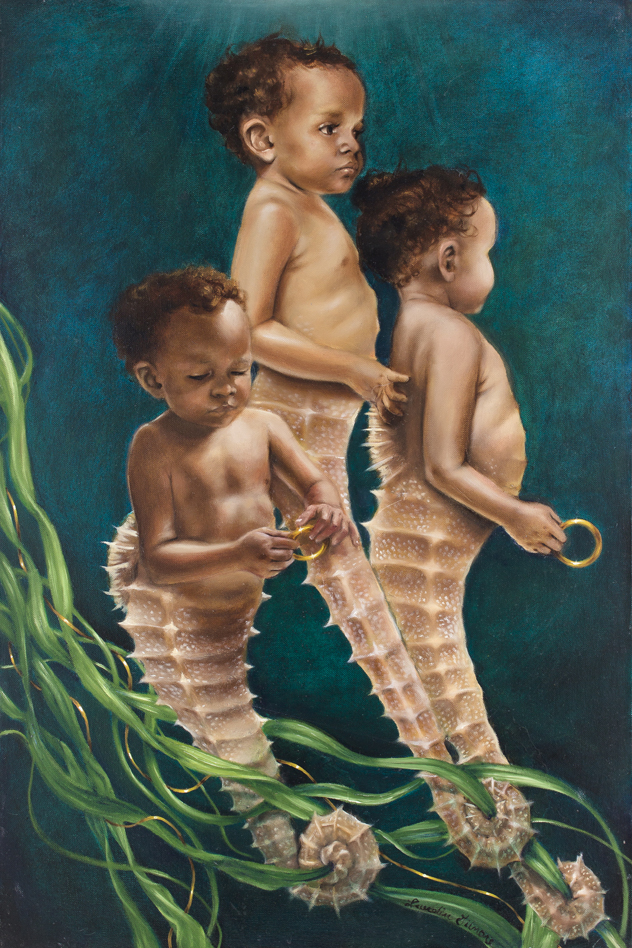
{Aquestrians}
Her tenure in that community begins with her very first sold drawing at a Sacramento City College art show (for which she still holds the $20 check “for posterity”), and continues with a stint at Gallery 2110 inside the Sacramento Art Complex, as well as entries in prominent shows. From 2012 to 2014, Gilmore had a studio space at Gallery 2110, where she earned commissions from several walk-ins. Though she loved the exposure, the downside was the 2nd Saturday traffic being able to see “things that were still in their creative womb,” she says. “I would often have a couple of easels up and people [would] see pieces in their infancy.”
Gilmore’s Self Portrait with Olivia drawing, of herself holding her infant daughter, was accepted to the 2007 California State Fair and sold. In 2013, Gilmore’s Coiled painting won Best in Show at the Sacramento Fine Art Center 2013 Animal House exhibit. “This is no small thing since there were some incredibly talented artists showing there,” she says.
Gilmore is looking to geographically spread her wings, and is on the hunt for more shows. But she’s calculatingly realistic about the prospects. “Last year I told myself I wanted to show in Los Angeles and New York and I did manage to get the former done,” she says. “I also want to do New Orleans and New Mexico. Basically, I’ve been looking for shows that I can drive to since you usually have to pay a fee to be curated, the gallery takes a percentage of any sales made, and it costs a lot to ship to out-of-town galleries. I decided I would only do shows that I could drive to unless there was something amazing like an international offer or something major that I couldn’t pass up.”
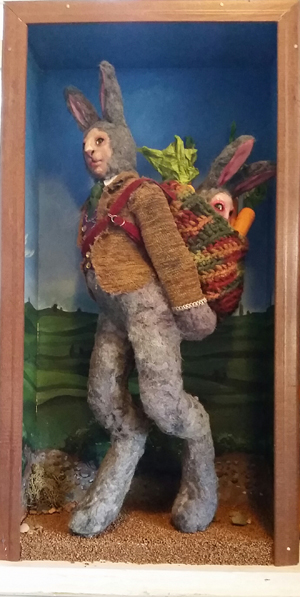
{From Market}
Making a living is a struggle when you’re a local artist, and for the most part, you either sell at one of your residencies or through constant word of mouth in the artist community. Gilmore, however, is optimistic about using cyberspace to boost her sales and maintain a semi-steady flow of income. She plans to open an online store connected to her website (Laurelingilmore.com) and branch out to other social media sites including Twitter.
“I’m not as active on the internet as I should be and stopped blogging a while back,” she says. “And while I do believe in artists telling their own experience, I just never really kept it up. Social media from my Facebook page has been a great way to get the word out, however, about shows and pieces I’ve done.”
For those who chose the uncertain path of being a full-time artist, it always helps to have a support system whether family, friends, or colleagues in her field. When pressed whether family has encouraged and acknowledged her chosen path as a legitimate one, Gilmore was quick to reply.
“It’s one of the questions many people ask me,” she says. “The fact remains that nobody ever told me to stop. My mother, husband, brother and two older sisters were always supportive of my endeavors and never questioned me. Additionally, I am still very close with the former owners of Gallery 2110 and they are great allies to have.”
Of course, no monetary value can take the place of human interaction and experiences. And while Gilmore has not become a millionaire overnight, it is her love for the art that has made a difference.
“Personally, I think my greatest triumphs have come from interacting with art lovers,” she says. “At the Sacramento Art Complex, I was so privileged to be able to meet and converse with so many people who had personal experiences relating to my art. There was a little boy who used to come in every single month with his mom and ask me questions about new work, old work, whatever. I really looked forward to seeing the two of them.
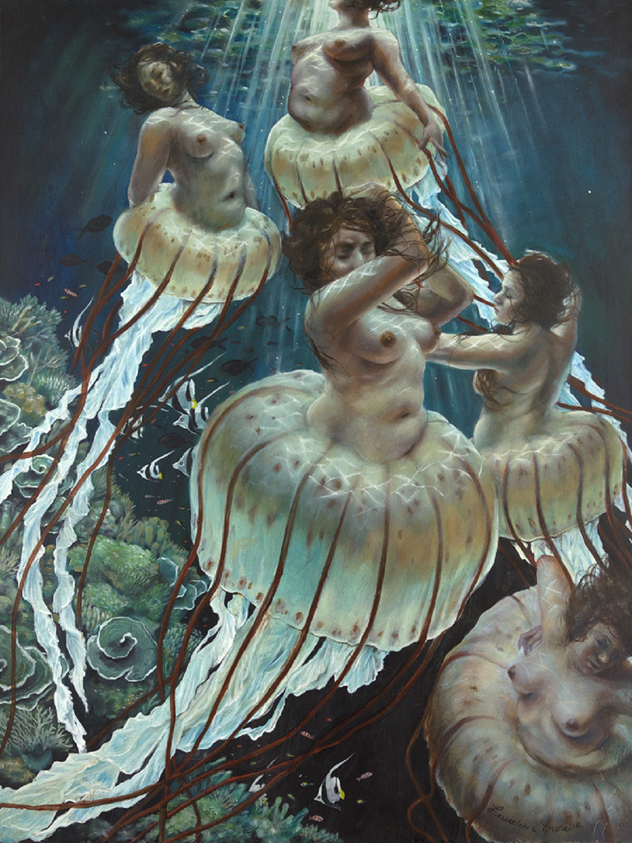
{Jelly Ballet}
“One woman told me that my painting, Jelly Ballet, has been used to inspire conversations about body image and body gratitude in her circle of friends. People told me they could see themselves, their loved ones in my work. I absolutely love hearing the stories people come up with around these creatures I’ve made. It means they inspire a thought process that goes in weird creative directions for people, and what else could I ask for?”
See for yourself at Gilmore’s upcoming show at Little Relics (908 21st Street, Sacramento), featuring shadow boxes and paintings. Opening reception is Thursday, April 9, from 6 p.m. to 8 p.m. For more info, visit Laurelingilmore.com
Artist Nate Page takes couch-surfing to a new level in his latest exhibit at Verge Center for the Arts
Sacramento has proven itself a thriving community for the arts, and there has been no shortage of artists wanting to showcase their wares at various galleries. And while most people equate art with the upper crust set and formal gatherings, many of the area’s hottest spots for seeing current pieces by emerging artists are, for the most part, lowbrow affairs.
One artist from Los Angeles’ Boyle Heights area, 39-year-old Nate Page, has made considerable headway across the country and even on an international level with his revelatory work and keen attention to nuance and detail.
Verge Center for the Arts, which is curated by the thoughtful Liv Moe, has opened its doors to Page’s Couchbleachers installation, which is literally a 55-foot-long bank of bleachers made up of wood and couches found in Sacramento. In turn, the installation has inspired a dedicated movie series—Friday Lunch Hour Movies—for those Sacramento workers who can enjoy a long lunch without any repercussions from his/her respective bosses.
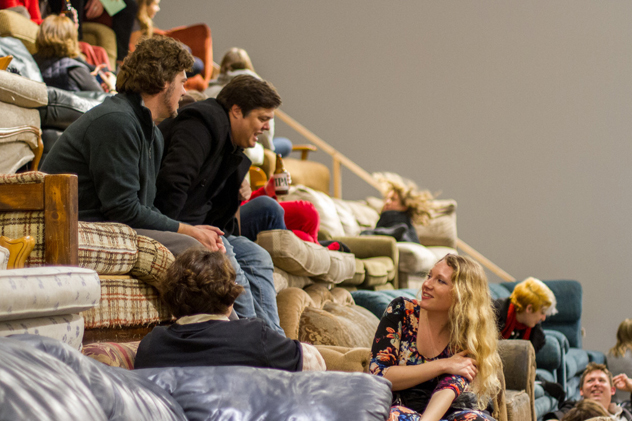
Page, however, has earned himself considerable accolades and some tidy sums of money in the way of scholarships and grants through his efforts working outside the box.
Although a part-time teacher by day to make ends meet, his greatest love is creating inspirational works that are not only functional and thought-provoking but also can be of use.
From his humble beginnings in Wisconsin through his time spent in New York and California, art has afforded Page the ability to be a part of many spectacles in different countries and cities. During a recent phone interview, he seemed very enthusiastic about his future.
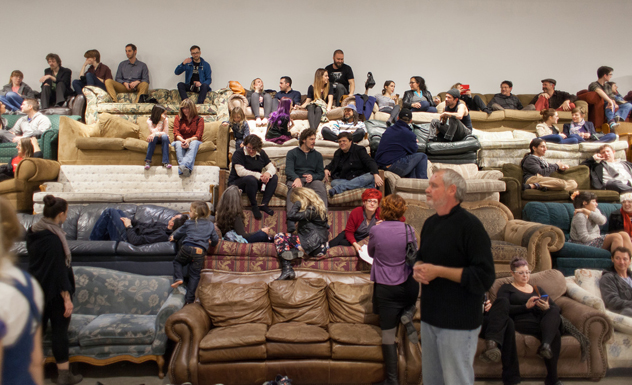
It’s no secret you’ve been doing art for most of your adult life. I love the art on your website and the different styles you’ve incorporated over the years. How did you get started?
My family actually was really not that into it. I think it all began when I just started doing stuff and making things by myself when I was kid. My grandfather, who recently turned 95, was a sign painter, and he got me thinking about making big pictures and things of a bigger scale. Come to think of it, he was always interested in what I was doing and was a big supporter of me in general although he didn’t understand most of it.
Are you able to make a full-time living from your art? What is your other day job?
I definitely need to work to pay bills. I teach a design class at Woodbury University in Burbank and am an adjunct professor in design. Right now I get anywhere from one to three days a week on the average, but it is my steadiest income source. Additionally, I love teaching and it’s totally another side of what I do. A lot of artists don’t teach since they can’t deal with students or don’t know how to interact on a personal level.
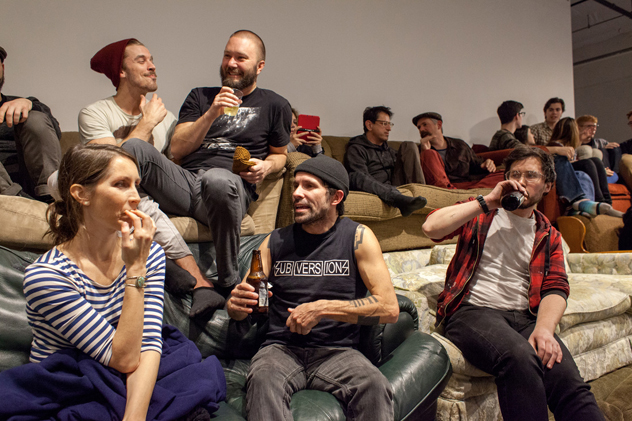
How did the Couchbleachers installation idea come about?
In 2011 I had the first Couchbleachers exhibit in Cleveland with Machine Project, a loose network run by Mark Allen that does a lot of installation. It was at a venue called Spaces Gallery and I just wanted to make something unique that was usable. A general contractor was hired to help create the piece while I drew up the plans and worked everything out as well. We also found new solutions about doing things of a larger scale. Since I often collaborate with different people and get help from venue staff to help, it can be beneficial to both parties. Since they already have a system set up in advance to deal with civic-scale environments, I often work that way.
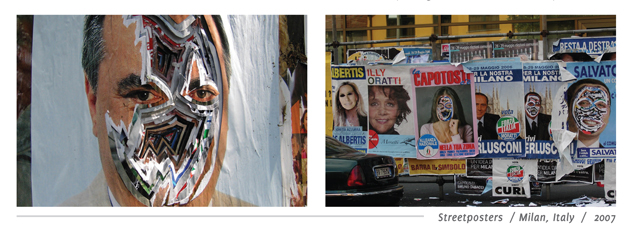
Have you ever thought about working in tandem with live musicians to create stage sets and costumes? It seems right up your alley given a lot of your specialized art [referring to his face art from Italy installation featured on his website].
Honestly, I’ve never done it. I’ve also never really had the opportunity to think about it since nobody has approached me for it. I’d definitely be interested in doing something, but I’d really need to get into the mindset of the band as a whole enterprise. Once more, it would be extremely important to understand and know the original intentions of the venue and artist and what they’re trying to emphasize and not.
Do you have any plans to include any other artists on current projects?
I don’t have any plans to collaborate with anyone. I only work with people in the institutional sense since they help me create the bridge to reality and produce what’s in my mind or on paper. Although I have done a lot of collaborating in the past, I’m in the headspace now where I want to work solo only.
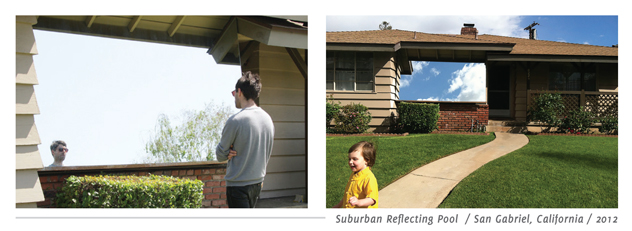
You’ve moved around quite a bit and have been anything but sedentary for most of your life, correct?
True. However, I have been living in Los Angeles for nine years, New York for six years and grew up in the small town of Waukesha, Wisconsin, which is a suburb of nearby Milwaukee. I used to live in Milwaukee as well right across the street from Eagles Ballroom [the area’s most popular live music venue]. There is a restaurant named Steny’s Tavern and Grill where I was a cook. It was a full-on biker hangout. It was a great job since I got all my meals for free and got to hang out with lots of Harley riders. Since Harley was developed in Wisconsin, it was very commonplace around there (and still is) to see bikers everywhere.
Tell us about your Cooper Union Summer Residency Program in New York City?
That was actually one where you needed to apply. It was much less personal than all the other residencies since it came with formalities and I was, ultimately, on a scholarship to go there. They gave me enough to get by but not to live on. At the time I was also dating a woman who was coincidentally from Milwaukee and lived there with her for roughly three years in the SoHo district. After we split up, I later moved into my own place in Bushwick [section of Brooklyn].
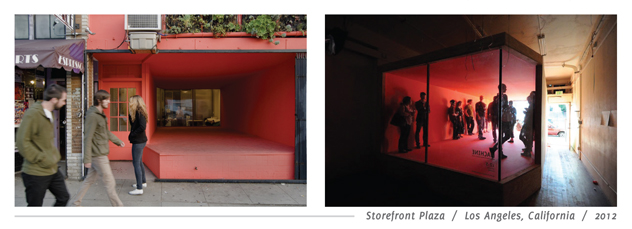
And what about your residencies abroad in Austria and Italy?
This well-known Austrian artist Heimo Wallner was doing a show in Milwaukee and somehow we got introduced. For some reason, we ended up at both my studio and my apartment and he liked what he saw obviously. At the time, I was living in there with my girlfriend and she had turned everything in the house including furniture and fixtures upside down at my apartment. We were in a fight at the time, and I totally forgot the place was a wreck. It seemed like he was more impressed by that visual than anything else but my artwork ended up getting me the gig at Hotel Pupik, Austria. Heimo was a big supporter of my early art life, and I thank him immensely for the guidance. In 2006, I had another installation at O’Artoteca in Milan, Italy. That one happened through a woman friend of mine named Sara Serighelli who I knew from my previous residency in Austria. It was very organic and she simply asked me one day after months of continued contact.
School is expensive and you’ve attended three different ones in three different states. Explain how it all worked out.
My parents helped me for undergraduate work but, unfortunately, I still have a decent amount of debt. I stay in contact with collectors, but, honestly, I simply tell them I don’t have it. I don’t have the extra money and they’re not going to get it while I need money for supplies and living expenses. Art school is ridiculous when you look at the money you pay and then the money you’re projected to get paid with that degree. You usually have to do a couple of different jobs to make ends meet and some people give up altogether. I’ve managed to make it work so far. I got the California Community Foundation Emerging Artist Fellowship grant for $15,000 a while back and have gotten others which have helped but were much smaller.
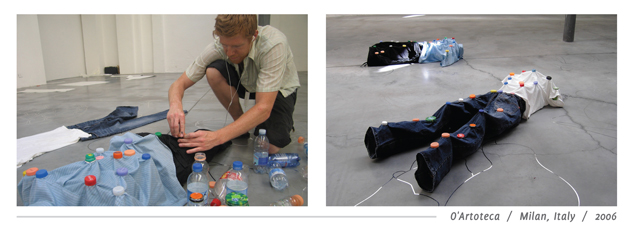
You’ve mentioned you like working solo. Is there any chance you’ll date again given your experience with furniture-arranging ex-girlfriends?
Right now I don’t have a girlfriend but you could say something is brewing. I’ll give it to you off the record, though.

Nate Page’s Couchbleachers runs Wednesday through Saturday from 11 a.m. to 6 p.m. and Sundays from 12 p.m. to 5 p.m. He’ll also be a featured speaker at Verge Center For The Arts’ In Conversation series on Wednesday, March 11 at 6:30 p.m. All ages are welcome and the event is free (although a $5 donation is suggested). For a full list of events, including a schedule of the remaining Friday Lunch Hour Movies and the upcoming Verge All Nighter slumber party/film festival, go to Vergeart.com. Verge Center for the Arts is located at 625 S Street, Sacramento.
We are living in an age of a do-it-yourself lifestyle. DIY is taking over home decor and design as people across the country flock to websites like Pinterest and eHow for inspiration on how to learn to make their own pillowcases, picture frames, light fixtures and more. The only downside to DIY? Not all of us are visual learners. It doesn’t matter how descriptive a YouTube video is, some of us need to learn kinesthetically! Laura Matranga of Asbestos Press caters to these learners in her Behind the Silkscreen workshop, where she teaches students how to transfer their own designs through silkscreening. From noon to 4 p.m. on Sept. 27 and 28, students will learn how to stretch designs, burn images and ink the screen to create re-usable “stamps” and images. Tickets can be bought for $130 at Brownpapertickets.com (search “Behind the Silkscreen”), a price that includes materials and a seat in this unprecedented class, hosted at Verge Center for the Arts (625 S Street, Sacramento). Get your seats soon, tickets will sell fast!
L.A. artist Mary Younakof puts the crayon big box to shame
Mary Younakof grew up in Los Angeles, but it took her latest artistic endeavor to see her city beyond what she previously viewed as just another congested metropolis.
343 Dresses: The Chromatic Convergence Project spotlights the random splashes of color camouflaged in L.A.’s concrete jungle. To do this, Younakof spent a year sewing 343 dresses—49 different tones of the seven colors of ROYGBIV (red, orange, yellow, green, blue, ivory and violet)—and staking out color-corresponding areas of L.A. to pose in for photos and videos.
The point, at first, was to depict the rainbow and L.A. in a new way; but over the last five years, as Younakof’s ideas continue to form around the dresses, the project has become more of a study of human interaction, the effect of color on the mind and much more.
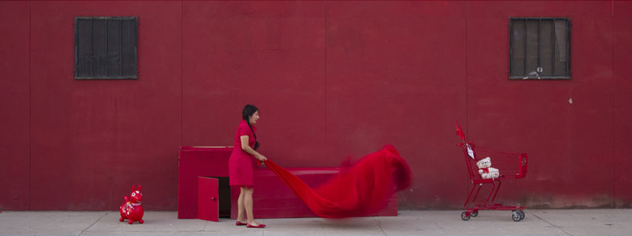
“It’s a project that has its own mind,” she says. “I initially had this very strict idea of how it was going to be. I thought, I’m going to make a dress every day and wear a dress every day but I realized that was impossible so I waited a year to make all the dresses first. I tried to direct the project but the project directed me.”
She started by researching the historical uses of rainbows in art and this eventually led to research on how people perceive colors.
“It’s almost like one step led to the next step and I spent almost one year creating the concept,” she says. “It was so big I needed to create a really specific formula for working with it.”
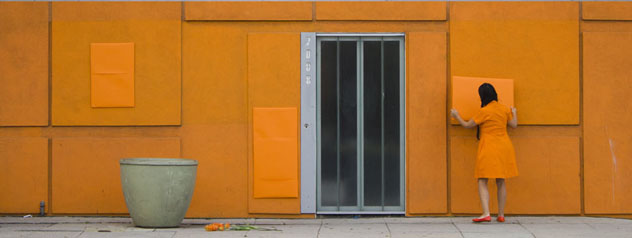
Younakof thus decided to use the number seven as the structure for the project because it was the number of colors in ROYGBIV, and because it seemed to naturally occur around her. The 343 dresses she created each have seven pieces to help keep with the theme.
“I was really interested in creating a dress that would have shape, form and mass,” she says. “It would be me against the landscape for the most part so I wanted to create form that is a little more sculptural. I thought, how can I use as much fabric as I can that takes up cubic space?”
To avoid walking around in a box, Younakof created a very simple but elegant pattern in seven pieces.

“It’s very distinctive and sculptural and people identified with it as the project unfolded because it was cohesive with the character I created,” she explains. “There were a lot of factors involved in designing that dress. A lot was driven by cost. I created something with no zippers or buttons. I wanted to do it simply.”
The dress became initially like a one-person performance piece. Younakof grew to love wearing each one, because she became a character within her own project and it felt like dressing up every day—but in the same thing. Only the textile changed the concept of the dress. Sometimes satin, other times taffeta or simple cotton.
“The textiles changed the mood of the dress,” Younakof says. “It felt different wearing a pink satin dress one day and a pink cotton dress the next.”
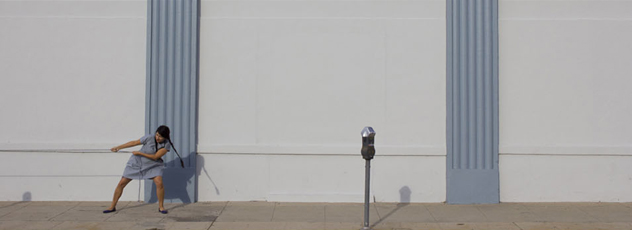
Younakof found the effects of the colors on other people most interesting. Complete strangers would often approach and tell her how they felt about the color.
“To have such a personal experience with it was really a much more powerful thing,” she says. “People migrate toward different colors and talk about them and have color associations and have nostalgia. I was not telling the stories, I was being told the stories.”
One of her favorite moments was a brief encounter with someone who simply wanted to identify with her, even without a story. “I remember walking into the market to buy groceries and the doors open, and I walk to the produce and this guy is pointing and waving his hand, and I’m like, who is he talking to? And I realize he is pointing at me. And then I point to me and he points to him and he is wearing an orange sweatshirt and I’m wearing an orange dress and we are 20 feet away from each other and just smile in understanding. Those interactions are the most fun.”

Before she started the project, red was Younakof’s favorite color. But after she began 343 Dresses, orange became her favorite because it attracted the most people to her.
“People tell me ‘Oh gosh, it reminds me of the orange teddy bear I had’ or their bedroom that was painted orange—there were very specific associations with the color orange,” she says. “But I think of all the colors I wore my favorites to wear were the hot pinks, because you don’t wear hot pink often. But the color orange compelled people to talk to me. The kind of stories that were told were heartfelt stories. I enjoyed wearing colors of pink that I wouldn’t get to wear but I really enjoyed orange because of what it brought to me.”
Conversely, she adds, she was horrified to wear some colors, like Shrek green.

“I was horrified but then it wasn’t that bad,” she laughs. “People looked at me and then went on their way.”
Along with her change in feelings for colors, Younakof changed her perspective on her home during the first year of wearing her dresses.
“It’s made me really focus on how color is integrated into the landscape,” she says. “Typically my experience of the city is you’re always dealing with traffic, trying to get somewhere, so this is looking at the city with a different pair of glasses. What was exciting for me was when I started to identify these colors in buildings while driving, or wherever I was, I noticed a lot of vibrant colors that people used on their buildings to create their place in the city. When you start to look you notice that other cities are not quite as colorful. Los Angeles is such a large metropolis associated with traffic and congestion but my project caused me to slow down and see my city in a microscopic way.”
Younakof’s photos and videos taken throughout the last few years do cause a double-take—she did not paint those sides of buildings with bright reds and blues, or purposely place a gigantic yellow smiley face on a truck in the middle of a parking lot. She made her environment pop—where before, it just blended into the background noise.

After her year of dress wearing ended, Younakof installed the pieces, outfits and all, at the Pacific Design Center in West Hollywood. Shortly after, galleries asked her to “perform” 343 Dresses and she incorporated the public into her project to showcase yet another aspect of how colorful life can be.
“Part of the initial concept was doing performances with a large group,” she says. “The first performance was an opera. I created this space in the Pacific Design Center where the [dress wearers] kind of spin around in space and create these color combinations based on numbers.”
Younakof worked with friends to create a composition based on the number seven. A German composer created the final piece and opera tenor Carlos de Antonis sang as members of the public performed around him. Since then, she has also performed in San Diego.

“I was invited to do some performances in San Diego so I invited the public to wear the dresses and they chose what colors they wanted to wear,” she says. “It’s interesting to see them create this community around the dresses. There were all ages and all genders. The last performance I had, had more men wearing the dress than ever. It was very exciting.”
[At the time of the interview] the Sacramento showing has not yet been fully planned, but Younakof says she is excited to take 343 Dresses somewhere different and see what happens in a different place.
“I think when people see it is an L.A.-based project and they see it through my eyes, they have said it could be so many places in the world,” she says. “And maybe that’s what happens in its own way, it brings together so many people who could be from anywhere. Just like L.A. is so diverse, it invites a very diverse crowd to come and be part of it. People are very attracted to color and they love seeing color. It was great to see people not knowing which dress to wear.”
343 Dresses started out about the spectrum of color in Younakof’s urban landscape, but as she continues to travel further out, she thinks more ideas will come to light.
“The beauty of it has kept inspiring me,” she says. “The ideas continue to come. It’s a project within a project within a project.”
To see what Younakof has in store for Sacramento, check out 343 Dresses: The Chromatic Convergence Project at the Verge Center for the Arts from Sept. 11 to Oct. 26, 2014. Opening reception is Sept. 11 from 6 to 9 p.m. For more info on the project and the artist, visit 343dresses.com.
On Thursday, June 5, Verge Center for the Arts will be celebrating the opening of their newly remodeled space with an exhibit featuring an artistically accessible treat for guests. The exhibit, curated by San Francisco visual and performing artist Yarrow Slaps and titled Champagne, celebrates the variety of cultural influences inspiring the 16 new and established artists featured in the show. The variety of media is incredibly diverse, ranging from photography to micro installations to minimalist murals. This free event strikes the artistic expression of both traditional and innovative styles exemplified from cultural influence. The opening reception runs from 6 to 9 p.m. at 625 S Street, but the exhibit will remain up through August 24, 2014. More information can be attained from Liv Moe by email (liv@vergeart.com), by telephone (916) 448-2985) or online at Vergeart.com
Jose Di Gregorio’s celestial shapes foretell Sacramento’s bright artistic future
In 2011, I walked into Bows and Arrows to browse some clothes and ingest either a coffee or a beer. I probably had some paperwork to do, but instead of doing anything that day, I just looked at a series of paintings exhibited on the wall. Those paintings—these large black backgrounds painted on wood with blue spray-paint accents that felt like something simultaneously underwater and atmospheric supported these large, brilliant white bodies or figures that were grounded between a few rudimentary geometric patterns and curling, waving tails that loped toward the bottom of the work—those paintings were composed by Jose Di Gregorio.
Now, I don’t know much about art, but occasionally I read some people who do. From what I can gather, the only thing a good artwork should do is negate reality in some fashion. This is not to mistake the desire of artworks to be considered realistic, or to be part of the material world that we exist in, but rather that they should act as mediators.
All of that is to say, in general, art that seeks to represent in a mimetic or realist fashion bores me. Our conditions today are so much more complicated and full of possibility than some bowl of fruit or a landscape. When I first came across Di Gregorio’s work, this is what it was clearly critiquing. This, for me, was its appeal. And I can only think of about two other Sacramento artists that I have remembered in similar fashion—but I’m not writing about them here.
Di Gregorio’s works are cosmic. They chose as their subject the infinite possibilities of our universe, and they hypothesize that these coordinates and celestial bodies might offer one of two things: either hope, of the sort that only post-apocalyptic genres can allude to, or humility, of the sort that alien encounter narratives tend to provide. Maybe they do both. What’s great about Di Gregorio’s works is that they are also questions in themselves, riddles of sorts. They offer each viewer her own Rorschach test, a reflection of her inner beliefs and ideologies. They suggest that each viewer can be validated externally, and because of this, Di Gregorio has patrons from physics professors to fanatics of the everyday divine.
His new show, Night, will be displayed at Bows and Arrows, some two years after his previous exhibit. It’s a shift from his larger works previously available at Bows, and at the Indianapolis Museum of Contemporary Art, where he just had an installation. In an effort to make his works more obtainable for enthusiasts, the sizes have been decreased, but the attention to detail is evident. The cosmic influence is still apparent, but these works are essentially circles or mandalas—a term Di Gregorio uses himself, though he’s quick to separate it from any spiritual association. Each of these mandalas holds a geometric figure, some series of white lines on a nebulous background composed by specific measurements within the frame, and they offer a continuation of the thoughts I was first attracted to in his earlier work.
“There’s some sort of meditative quality to them,” says Di Gregorio. “And I’m not a spiritual guy at all.”
Each of these pieces has a different geometric rhythm, a different figure or shape that holds the frame together. The white lines are crafted, composed with detail and attention. Their initial appearance seems simple, yet the specific shapes and lines reveal a concentration, a repetitious series of paint and articulation. It is because of these recursive structures, shapes, figures and the cosmic image set, that the spiritual qualities are easy to identify.
“The spiritual nature of these pieces comes up a lot,” says Di Gregorio. “I used to be a pretty outspoken atheist. [Yet,] I feel like these works are my ways of seeing the spiritual.” This seeing the spiritual, I’d associate with the sort of focus that artists must possess, not only to create works, but to continue to create them in our chaotic, distracting contemporary. It’s a sort of satisfaction that I’ve often thought of as addiction.

One could say Di Gregorio is addicted to simple figures and infinite depth. “There’s something about drawing a white line on a black surface,” he says, and then pauses to consider it further. It’s clear at this moment that his craft has a visceral effect on Di Gregorio, that the reason he pursues art has something to do with the metaphysical experience of drawing a line. This inversion of black and white, the associations of figure and background, is part of how Di Gregorio turns the subject of his works on its head. He never finishes this thought during our time together, to tell me what that “something” is.
Instead, I might offer that space is infinite, dark, unclear. An artwork is fixed, illuminated, specific. Traditionally the canvas is light, the marks dark. An opaque background asks for figures that register as shadows, bodies, inversions of light. A pitch dark background asks for figures that register as bodies of light themselves. This is part of that negation I mentioned above. However, it’s likely not how Di Gregorio would describe his work: “I don’t have a deep philosophical notion of what I do. It’s celestial, of course.”
“When I was an undergrad,” Di Gregorio continues, “I was researching the works of Caspar David Friedrich. He was a romantic painter during the Enlightenment. He was sort of countering the Enlightenment philosophy with the idea of the sublime, how small we are. That idea of the whole.”
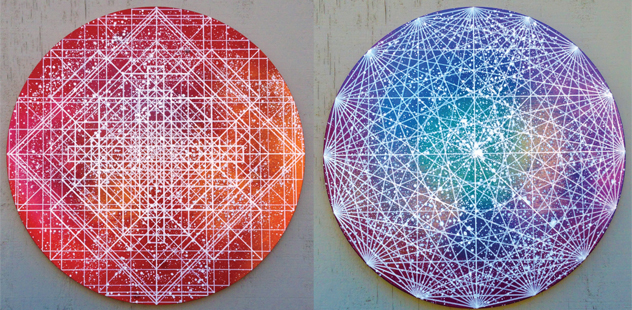
This influence is clear once one sees the vast landscapes and seascapes of Friedrich, the horizons that loom over the lower third of the works, the immense skies with all of their impossibilities dominating the space of the canvas. Change the subject to space, swap out the human bodies for geometric figures, add a touch of improvisation and post-expressionist impulse: this is Di Gregorio.
The subject of his works is complicated, but his continual return marks Di Gregorio’s works with a specific focus. As he explains, “Maybe I’m just fascinated with something that is hard to explain. The feeling of being overwhelmed. We want to describe it, and maybe I’m describing it visually.”
That feeling of being overwhelmed isn’t lost on the community of Sacramento. Di Gregorio recalls the recent Capital Artists’ Studio Tour at Verge Center for the Arts, where many local art enthusiasts would peek into his workroom, glance at the untraditional works, and quickly slide back out the door. He laughs, recalling a question one patron asked another Verge staff member: “Do the artists here show their works anywhere?” These well meaning sponsors of the arts, I might offer, are overwhelmed by Di Gregorio’s works as well—just in a slightly different way.

This incident stands out for Di Gregorio, having just completed an exhibition at the Indianapolis Museum of Contemporary Art. This might be the highlight of his artistic career. “It was the best show I’ve ever had,” he says. “It was all flat black, the walls, the ceiling, everything. We used red and blue light, and the works really popped. It was like a heavy-metal planetarium. I had just gone to the Lawrence Hall of Science Planetarium [in Berkeley] with my daughters. It was such a profound experience; I just wanted to mimic that. I got a budget. They flew me out. I did a mural. It was great.”
“I wish I could be an installation artist all the time,” he adds. “That is it. I got that taste.”
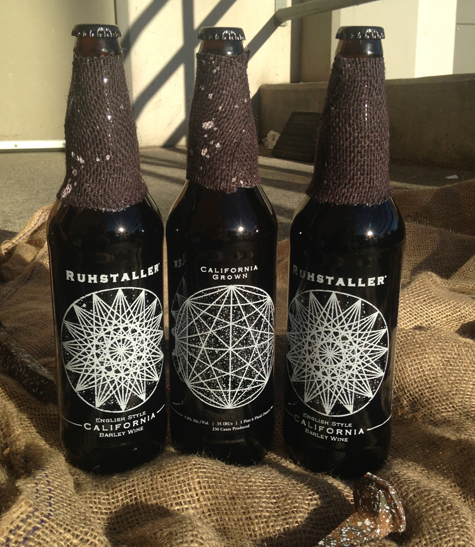
To go along with his recent accomplishments, Di Gregorio has recently shown at Sol Collective, designed a limited edition bottle for Ruhstaller Beer, designed and crafted a huge artwork for the recent Launch Music Festival in collaboration with others, and provided some aesthetic touches to the McKinley Park playground rebuild.
“That was over 100 hours in just one week,” elaborates Di Gregorio, “14-hour days, leaving at 6:30 AM and getting home at 9:30. Most of the work was in the mosaic, and I’m not a mosaic artist. I created this lunar/solar mosaic, and another one in the entryway. That took a lot of time, cutting the tiles and getting the right colors. People who go there always notice the lionfish. Actually, the climbing wall and the lionfish were an afterthought. It’s funny how things work. I live in the area, so it’s a humbling thing.”
Having grown up in Woodland, Jose Di Gregorio is excited to be included in the community of Sacramento. He sees a lot of possibility here: “I think that there’s going to be positive change in what happens in Sacramento art. I want to think we’re getting beyond a sculpture of a bowl, or a cowboy, like Old Sac stuff, the Wild West.”
With works from artists like Di Gregorio, here’s hoping that we might soon be recognized as stellar or even universal.
Night, an exhibition of new work by Jose Di Gregorio and Jared Tharp, will be on display at Bows and Arrows in Sacramento Oct. 4 through Oct. 31, 2013. An opening reception will take place on Oct. 4 from 6 to 9 p.m. For more info, visit Bowscollective.com.


